Unit 4 Earthquakes单元教案
文档属性
| 名称 | Unit 4 Earthquakes单元教案 | 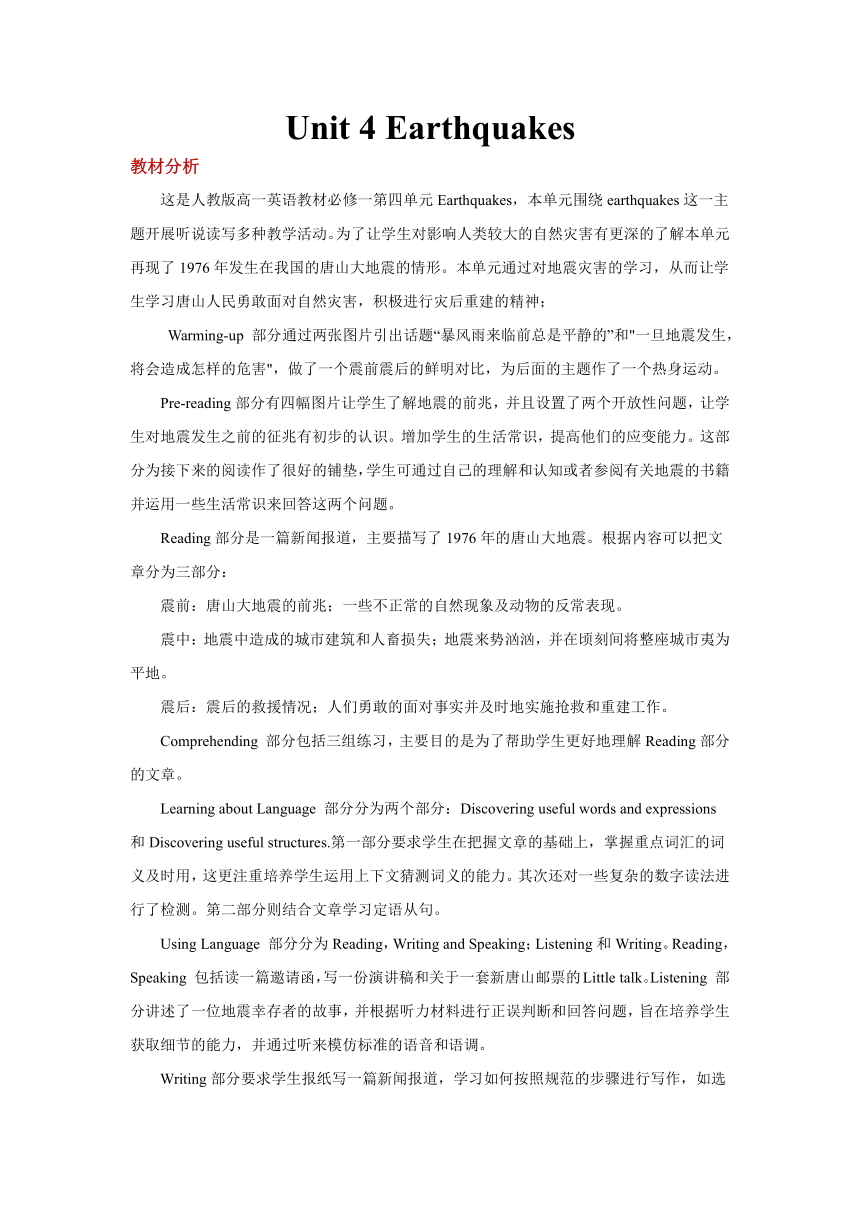 | |
| 格式 | zip | ||
| 文件大小 | 159.0KB | ||
| 资源类型 | 教案 | ||
| 版本资源 | 人教版(新课程标准) | ||
| 科目 | 英语 | ||
| 更新时间 | 2019-07-28 22:06:54 | ||
图片预览

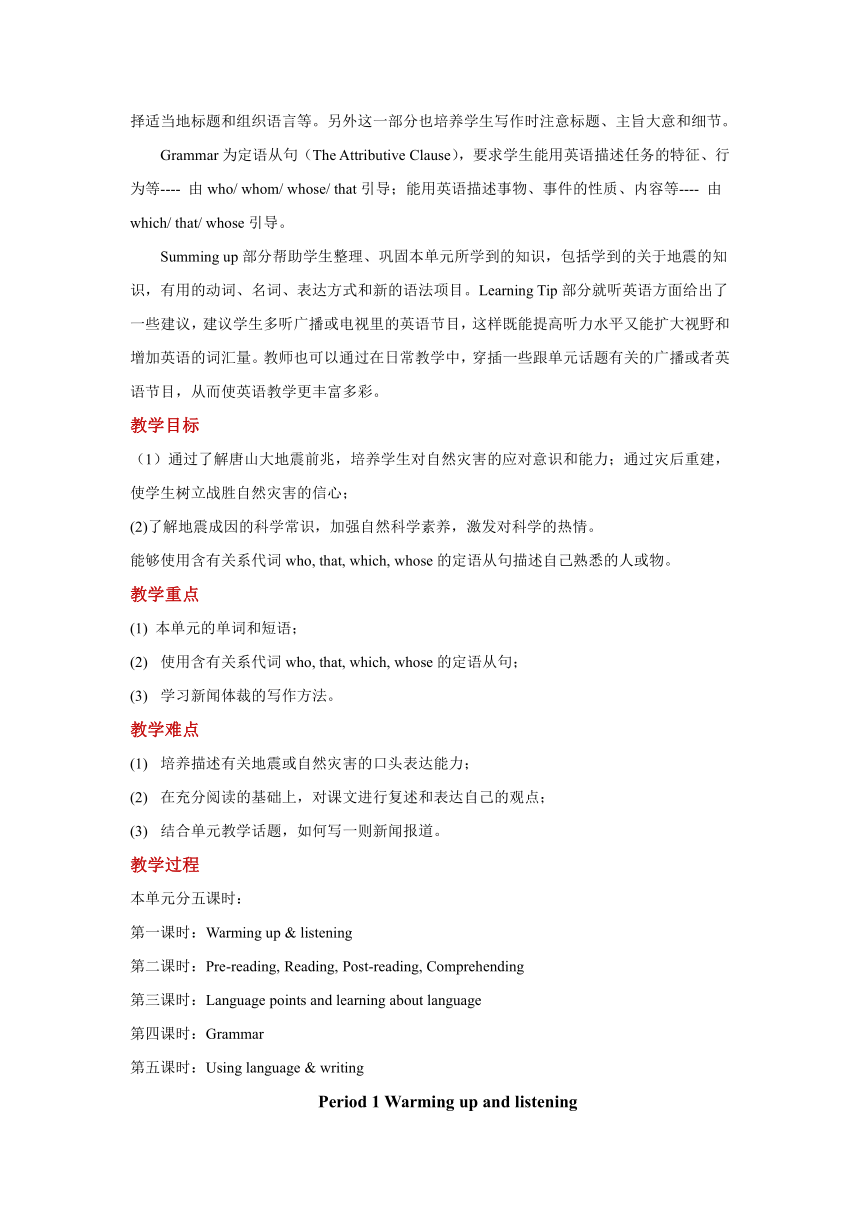
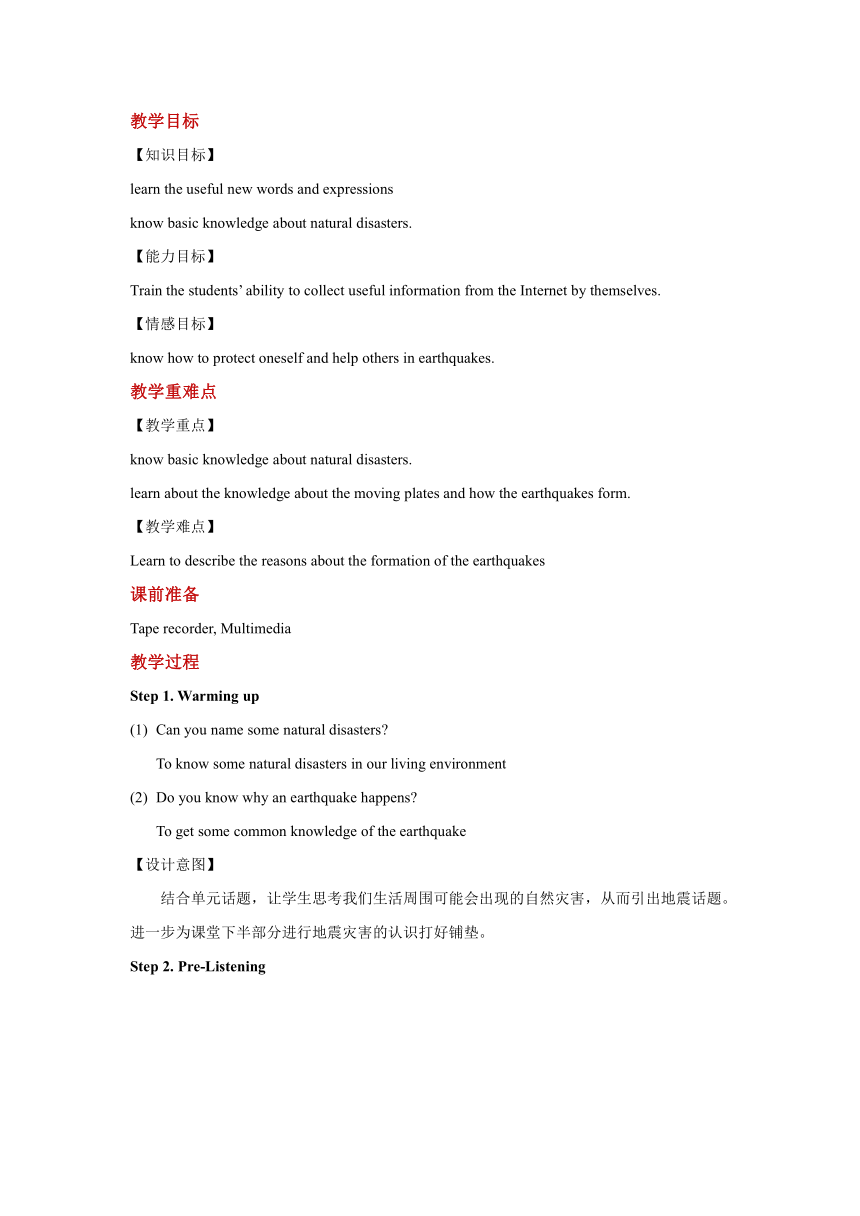
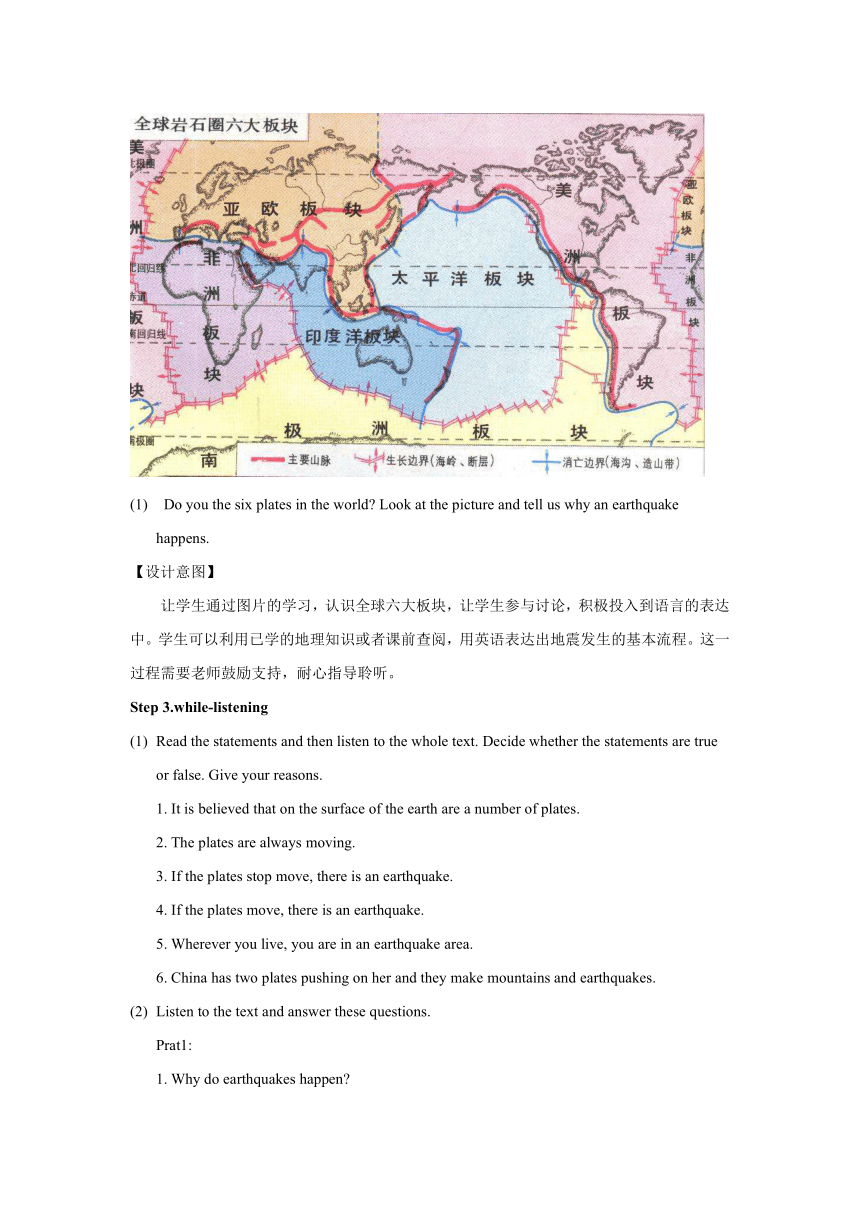
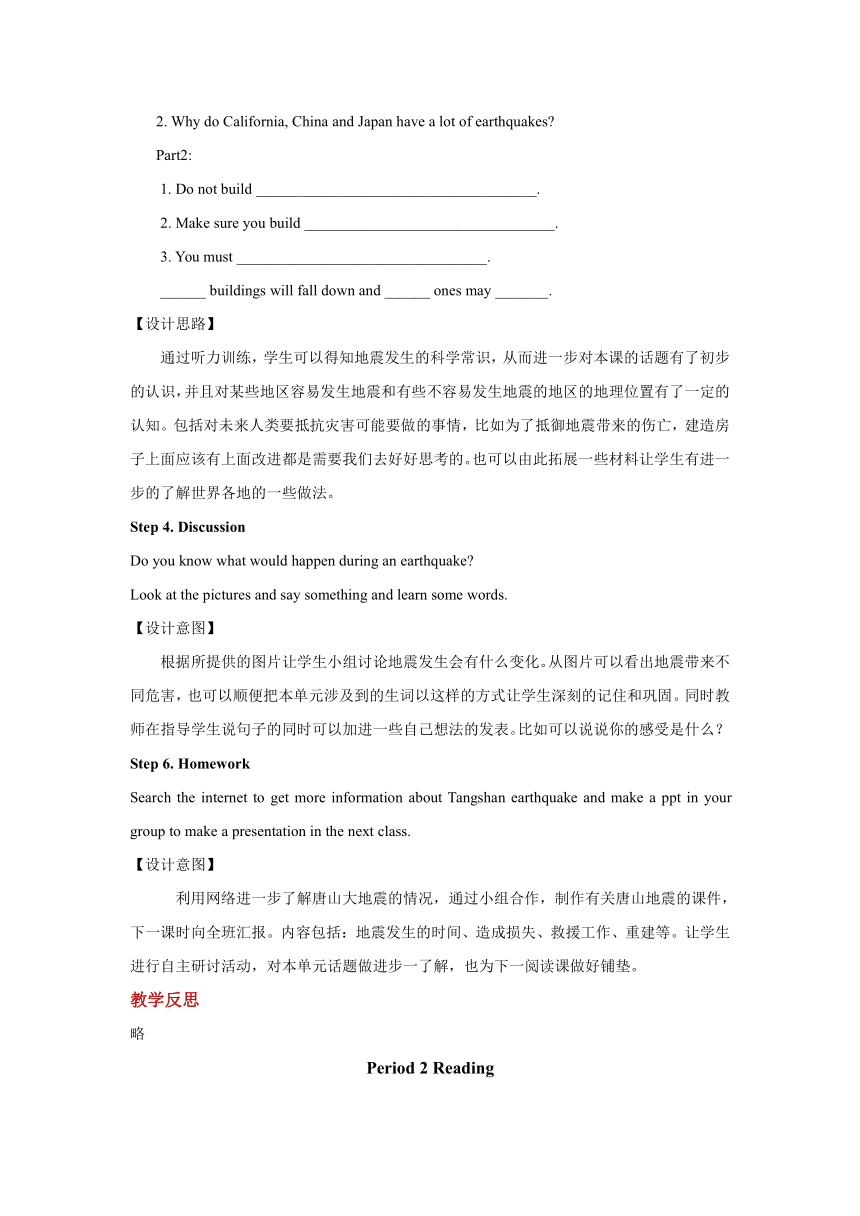
文档简介
Unit 4 Earthquakes
教材分析
这是人教版高一英语教材必修一第四单元Earthquakes,本单元围绕earthquakes这一主题开展听说读写多种教学活动。为了让学生对影响人类较大的自然灾害有更深的了解本单元再现了1976年发生在我国的唐山大地震的情形。本单元通过对地震灾害的学习,从而让学生学习唐山人民勇敢面对自然灾害,积极进行灾后重建的精神;
Warming-up 部分通过两张图片引出话题“暴风雨来临前总是平静的”和"一旦地震发生,将会造成怎样的危害",做了一个震前震后的鲜明对比,为后面的主题作了一个热身运动。
Pre-reading部分有四幅图片让学生了解地震的前兆,并且设置了两个开放性问题,让学生对地震发生之前的征兆有初步的认识。增加学生的生活常识,提高他们的应变能力。这部分为接下来的阅读作了很好的铺垫,学生可通过自己的理解和认知或者参阅有关地震的书籍并运用一些生活常识来回答这两个问题。
Reading部分是一篇新闻报道,主要描写了1976年的唐山大地震。根据内容可以把文章分为三部分:
震前:唐山大地震的前兆;一些不正常的自然现象及动物的反常表现。
震中:地震中造成的城市建筑和人畜损失;地震来势汹汹,并在顷刻间将整座城市夷为平地。
震后:震后的救援情况;人们勇敢的面对事实并及时地实施抢救和重建工作。
Comprehending 部分包括三组练习,主要目的是为了帮助学生更好地理解Reading部分的文章。
Learning about Language 部分分为两个部分:Discovering useful words and expressions 和Discovering useful structures.第一部分要求学生在把握文章的基础上,掌握重点词汇的词义及时用,这更注重培养学生运用上下文猜测词义的能力。其次还对一些复杂的数字读法进行了检测。第二部分则结合文章学习定语从句。
Using Language 部分分为Reading,Writing and Speaking;Listening和Writing。Reading,Speaking 包括读一篇邀请函,写一份演讲稿和关于一套新唐山邮票的Little talk。Listening 部分讲述了一位地震幸存者的故事,并根据听力材料进行正误判断和回答问题,旨在培养学生获取细节的能力,并通过听来模仿标准的语音和语调。
Writing部分要求学生报纸写一篇新闻报道,学习如何按照规范的步骤进行写作,如选择适当地标题和组织语言等。另外这一部分也培养学生写作时注意标题、主旨大意和细节。
Grammar为定语从句(The Attributive Clause),要求学生能用英语描述任务的特征、行为等---- 由who/ whom/ whose/ that引导;能用英语描述事物、事件的性质、内容等---- 由which/ that/ whose引导。
Summing up部分帮助学生整理、巩固本单元所学到的知识,包括学到的关于地震的知识,有用的动词、名词、表达方式和新的语法项目。Learning Tip部分就听英语方面给出了一些建议,建议学生多听广播或电视里的英语节目,这样既能提高听力水平又能扩大视野和增加英语的词汇量。教师也可以通过在日常教学中,穿插一些跟单元话题有关的广播或者英语节目,从而使英语教学更丰富多彩。
教学目标
(1)通过了解唐山大地震前兆,培养学生对自然灾害的应对意识和能力;通过灾后重建,使学生树立战胜自然灾害的信心;
(2)了解地震成因的科学常识,加强自然科学素养,激发对科学的热情。
能够使用含有关系代词who, that, which, whose的定语从句描述自己熟悉的人或物。
教学重点
(1) 本单元的单词和短语;
(2) 使用含有关系代词who, that, which, whose的定语从句;
(3) 学习新闻体裁的写作方法。
教学难点
(1) 培养描述有关地震或自然灾害的口头表达能力;
(2) 在充分阅读的基础上,对课文进行复述和表达自己的观点;
(3) 结合单元教学话题,如何写一则新闻报道。
教学过程
本单元分五课时:
第一课时:Warming up & listening
第二课时:Pre-reading, Reading, Post-reading, Comprehending
第三课时:Language points and learning about language
第四课时:Grammar
第五课时:Using language & writing
Period 1 Warming up and listening
教学目标
【知识目标】
learn the useful new words and expressions
know basic knowledge about natural disasters.
【能力目标】
Train the students’ ability to collect useful information from the Internet by themselves.
【情感目标】
know how to protect oneself and help others in earthquakes.
教学重难点
【教学重点】
know basic knowledge about natural disasters.
learn about the knowledge about the moving plates and how the earthquakes form.
【教学难点】
Learn to describe the reasons about the formation of the earthquakes
课前准备
Tape recorder, Multimedia
教学过程
Step 1. Warming up
Can you name some natural disasters?
To know some natural disasters in our living environment
Do you know why an earthquake happens?
To get some common knowledge of the earthquake
【设计意图】
结合单元话题,让学生思考我们生活周围可能会出现的自然灾害,从而引出地震话题。进一步为课堂下半部分进行地震灾害的认识打好铺垫。
Step 2. Pre-Listening
Do you the six plates in the world? Look at the picture and tell us why an earthquake happens.
【设计意图】
让学生通过图片的学习,认识全球六大板块,让学生参与讨论,积极投入到语言的表达中。学生可以利用已学的地理知识或者课前查阅,用英语表达出地震发生的基本流程。这一过程需要老师鼓励支持,耐心指导聆听。
Step 3.while-listening
Read the statements and then listen to the whole text. Decide whether the statements are true or false. Give your reasons.
1. It is believed that on the surface of the earth are a number of plates.
2. The plates are always moving.
3. If the plates stop move, there is an earthquake.
4. If the plates move, there is an earthquake.
5. Wherever you live, you are in an earthquake area.
6. China has two plates pushing on her and they make mountains and earthquakes.
Listen to the text and answer these questions.
Prat1:
1. Why do earthquakes happen?
2. Why do California, China and Japan have a lot of earthquakes?
Part2:
1. Do not build _____________________________________.
2. Make sure you build _________________________________.
3. You must _________________________________.
______ buildings will fall down and ______ ones may _______.
【设计思路】
通过听力训练,学生可以得知地震发生的科学常识,从而进一步对本课的话题有了初步的认识,并且对某些地区容易发生地震和有些不容易发生地震的地区的地理位置有了一定的认知。包括对未来人类要抵抗灾害可能要做的事情,比如为了抵御地震带来的伤亡,建造房子上面应该有上面改进都是需要我们去好好思考的。也可以由此拓展一些材料让学生有进一步的了解世界各地的一些做法。
Step 4. Discussion
Do you know what would happen during an earthquake?
Look at the pictures and say something and learn some words.
【设计意图】
根据所提供的图片让学生小组讨论地震发生会有什么变化。从图片可以看出地震带来不同危害,也可以顺便把本单元涉及到的生词以这样的方式让学生深刻的记住和巩固。同时教师在指导学生说句子的同时可以加进一些自己想法的发表。比如可以说说你的感受是什么?
Step 6. Homework
Search the internet to get more information about Tangshan earthquake and make a ppt in your group to make a presentation in the next class.
【设计意图】
利用网络进一步了解唐山大地震的情况,通过小组合作,制作有关唐山地震的课件,下一课时向全班汇报。内容包括:地震发生的时间、造成损失、救援工作、重建等。让学生进行自主研讨活动,对本单元话题做进步一了解,也为下一阅读课做好铺垫。
教学反思
略
Period 2 Reading
教学目标
【知识目标】
Get the students to learn the following useful new words and expressions in this passage
Get the students to know basic knowledge about natural disasters.
【能力目标】
Develop the students reading ability and let them learn different reading skills.
Train the students’ ability to collect useful information from the Internet by themselves.
【情感目标】
Get the students know damages earthquakes bring about and the ways to reduce losses of earthquakes.
Get the students to know how to protect oneself and help others in earthquakes.
Get the students to be aware of terrible disasters, meanwhile get them to face it, treat it in a proper way, and never get discouraged.
教学重难点
【教学重点】
Get the students to learn about Tangshan Earthquake.
Get the students to learn different reading skills.
【教学难点】
Develop the students’ reading ability.
课前准备
Tape recorder, Multimedia
教学过程
Step 1. Warming-up
1.Review the natural disasters in the last class.
2. Watch the video and tell us what is the video about?
What can you see in the video?
【设计意图】
利用视频导入,一方面可以激发学生的学习兴趣和探究的动机,另一方面,为学生提供话题导入新课。让学生从真实的视频里面感知地震所带来的危害,和一些巨大的影响。
Step 2.Pre-reading
Think it over:
What may happen before an earthquake?
【设计意图】
结合课文几幅图片,给学生一个自我描述地震前的一些状况,让学生更好的进入文章学习。
Step3. Reading
To learn Skimming and Scanning
To explain steps for Skimming and Scanning
【设计意图】
展现高中阅读的两种基本方法,体现获取信息的关键性和准确性,帮助学生形成一些良好的阅读习惯,聚焦于各种提示和相关信息,激发学生的好奇心和阅读关注度。
Structure of the text(Time order)
1. Before the earthquake (Paragraph _______)
2. During the earthquake (Paragraph _______)
3. After the earthquake (Paragraph _______)
【设计意图】
梳理清楚课文线索。为各个环节的理解和开展做铺垫。整体粗读,领略内容大意。
PART1:Before the earthquake
What strange things happened before Tangshan Earthquake?
A.______________________________________________________________________
B. .______________________________________________________________________
C. .______________________________________________________________________
D. .______________________________________________________________________
What’s the reaction of people in this city?
________________________________________________________________________
PART2: During the earthquake
Data: _____ of the nation felt the earthquake.
A huge crack that was __ kilometers long and _____ meters wide cut across houses.
In ___ terrible seconds a large city lay in ruins.
____ of the people died or were injured during the earthquake.
The number of people who were killed or injured reached more than ________.
All of the city’s hospitals, _____ of its factories and buildings and _____ of its homes were gone.
PART3: After the earthquake
What happened after the earthquake?
The army:
Workers:
Result:
【设计意图】
细读环节的任务有两个方面,其一是通过细读,学生学会查找细节信息的能力。对这种能力的培养可以通过让学生完成相关的阅读任务而形成,教师可以设计这样的任务,如正误判断、简单回答问题,填写表格,按某一逻辑顺序排列句子,等等通过仔细阅读课文还要求学生更深层地理解课文,即作者的心理状态、理解作者表达的言外之意。
Step4. Post-Reading
Discussion:
1. Why the title is A NIGHT THE EARTH DIDNT SLEEP?
2. What does the sentence “Slowly, the city began to breathe again” mean?
3.Imagine that you are having a class when an earthquake happens, how can you protect yourselves?
【设计意图】
要求学生带着问题快速浏览文章,从阅读材料中,迅速查找这些特定的信息和具体的事实。通过仔细阅读课文还要求学生更深层地理解课文,即作者的心理状态、理解作者表达的言外之意。深层理解任务的设计可以结合读后活动进行,如设计回答问题,讨论等。
Step5. Homework
1.Finish the exercises in your book.
2. write down your suggestions when an earthquake happens in the classroom.
【设计意图】
进行知识迁移,让学生提高在自然灾害中自我保护的意识和保持冷静的心态,帮助学生通过处理灾难事件学会控制自己的情绪,科学有效的保护自己和帮助他人。
教学反思
略
Period 3 Language Points Learning
教学目标
【知识目标】
The useful expressions from the text
The examples and practices of important words and phrases
【能力目标】
To learn words and expressions in a proper way
To conclude the use of some expressions
【情感目标】
To help students understand the new expressions
To look for a better way of learning words and expressions
教学重难点
【教学重点】
The different pattern of words and the related expression
【教学难点】
To use new expressions in different situations
课前准备
Tape recorder, Multimedia
教学过程
Step1. Warming Up
Revision (Retelling of the text)
Who?/When?/Where?/Why?/What?/How?
Dictation (Asking some group members to dictate new expression by listening)
【设计意图】
增加学生的参与性,在确认学生之前学习的效果之上,再开展新一轮的语言知识学习,确保学生的输入基础,尤其是对于知识的内化程度和继续学习的学习情绪。
Step2. Checking the dictation
rise
in ruins
injure
shock
as if
rescue
extreme
at an end
a great number of
burst
【设计意图】
重点在于根据读音记单词的方法渗透,在听写中兼顾英英释意的表达形式,让学生避免单纯根据中文写英文的模式,尽可能多的尝试听写中对于目标词汇的表述,同时可以有目的的指定学生在黑板做演示,订正的过程中提醒学生关于词性和搭配等细节。
Step3. To find the proper expressions above
1. _______ an increase in an amount
2. __________ a lot of
3. _________ finished
4. ________ very great in degree
5. ______ cause injuries or bodily harm to
6. ______ make someone feel very surprised
7. _____ the act of exploding or bursting
8. _____ save something or somebody from danger
9. _____ the part of a building left after the rest has been destroyed
10._____seem like; look like
【设计意图】
从初中至高中的转变中,保持英英释意是英语学习思维中一个重要的环节,先通过相关词义描述和对应选择,其实是想帮助学生先降低学习难度,让学生先习惯,再提高要求,为学生自己合理使用字典做好铺垫。
Step4. Discussion before teaching
rise burst think of as if at an end lay in ruins injure shock rescue bury a great number of extreme
Making a handout for students in each group to read all the language points clearly
To learn it by checking dictionary and make notes by themselves
To prepare for sharing
【设计意图】
激发学生主动学习的能力,通过制作单元词汇和短语的学案,让学生第一时间对于所有知识点有量和整体感,再通过分派学习任务,从个人查阅字典到小组合作呈现团队合作成果,从被动的听课,记笔记的模式逐渐转变,对于新的知识点进行探索,从课本表达到例句到使用字典或者借助各种手头工具书,进行笔记的筛选,选择自己印象深刻的记忆内容,帮助学生有效地实现知识输入。
Step3. Presentation
To choose a well-performed group to present in the class
To give some better suggestions
To draw a conclusion or give examples to students
【设计意图】
小组展示,因课堂时间有限,所以教师可以根据学生准备过程中的情况先预备好完成较为符合英语学习习惯的小组进行笔记探索的展示,从学生的角度帮助学生完善学习方法,以鼓励为主,再进行教师的归纳展示,让学生产生模仿的意识。
Step4 Homework
Doing different exercises or related exercises from books
【设计意图】
集中练习重点单词于词组的表达与使用,增强学生的语境切换,让学生手中的练习得到充分的归类使用,同时进行查漏补缺的笔记整理。
教学反思
略
Period 4 Grammar: The Attributive Clause
教学目标
【知识目标】
Use the attributive clause containing the relative pronoun who, that, which, whose
The rules of changes in attributive clause
【能力目标】
To describe the person or thing you know orally by using attributive clause
【情感目标】
Students can use the attributive clause to describe effectively
Students can communicate fluently
教学重难点
【教学重点】
The rules of changes in attributive clause
【教学难点】
Students can use the attributive clause to describe themselves correctly
课前准备
Tape recorder, Multimedia
教学过程
Step1. Warming up
Preview the attributive clauses that used in the reading passage.
Let students to fill in the blanks according to the understanding about the passage.
【设计意图】
通过重读课文,找出文章使用过的定语从句的句子,让学生明白学以致用的道理,也懂得我们的语法知识是贯穿在整个单元中的,从而让学生为接下来定于从句的认知做了一个很好的热身。
Step2. Observation
什么是定语?
Tangshan earthquake was a terrible quake. The quake caused great damage.
→Tangshan earthquake was a terrible quake which caused great damage.
定语从句的相关概念
1.定义:在复合句中修饰______或______的从句
2.结构:______+______+从句
3.先行词:被从句修饰的名词或代词
4.关系词:指代______,引导______,在从句中_______
关系代词:that, which, who, whom, whose (可充当的成分有: )
关系副词:when, where, why (可充当的成分有: )
【设计意图】
结合单元话题句子,通过分析句子的构成,让学生感知定语从句的组成部分,读懂定语从句的相关概念,对初中学过的部分知识做了一次直观的回顾,转变常规的教学过程,先让学生对语法点有个基本的认识,结合单元话题,进行教学的整合。
Step3. Further study
内容 Task1, Task2, Task3, Task4
要求 1. First do it by yourself. Then discuss in your group. 2. Be efficient and quick 3. Group leaders control the process and time 4. Discuss actively 5. Make notes
目标 To solve your problems.
Task 1
找出关系词在从句中的作用
Water in the village wells that/which were very calm usually rose and fell, rose and fell.
Mice (that/which) people could seldom see in the daytime ran out of the fields.
Smelly gas came out of the wells whose walls had deep cracks.
People who/that didn't go to sleep saw bright lights in the sky.
People (who/whom/that) the strange noise awoke didn't see any plane.
Farmers whose chickens and even the pigs were too nervous to eat didn't notice the strange things.
关系代词用法小结:
指人 指物 subject object attribute
that
which
who
whom
whose
Task 2 填入适当的关系代词,完成下列定语从句 (that, which, who, whom, whose, 不填)。
Damage of the quake:
Earthquake destroyed the tall buildings __________ were modern and beautiful.
Earthquake ruined the bridges __________ people need in their daily life.
Earthquake caused some deep cracks __________were very dangerous.
The supply of electricity __________ function plays an important part in people's life was cut off.
Aftershock __________ great quake will cause appeared.
The number of people __________ got injured in the quake was large.
The happy life __________people once had come to an end.
People __________homes were destroyed by the earthquake became homeless.
Task3: when an earthquake comes, we should/can/had better…
Task4: A report about the typhoon
【设计意图】
第一步骤先让学生对定语从句有了一个大概的认知,激发原有的知识。此处开始进行任务设置,让学生学习语法是通过自己和团队合作从而得出结论,而不是教师牵着鼻子走。通过自己和小组合作得出的成果,鼓励学生有意识的做好笔记,并进行课堂习题解答。此部分分为四个任务,第一个任务是通过句子理解得出定语从句的规律,填好表格一目了然。第二个任务是通过句子的理解开始判断自己的认知是否正确。第三个任务是关于地震来了我们应该怎么做,采取的措施里面使用定语从句表达自己的观点。最后一个任务是关于完成一篇有关台风篇章的填空,做到把所学知识进行实践操作,从句子到篇章的一个过程。四个任务都由学生自己支配,教师可以分不同层次或者根据题目的难易程度,分个人和小组合作形成完成。
Step4. Homework
Composition:
What should we senior school students do to protect environment?
(用尽可能多的定语从句写一篇短文。)
【设计意图】
最后的输出是一个开放式的小作文,关于作为一个高中生,我们能为我们的环境做点什么,这样是这个单元话题所倡导的,通过学习了自然灾害,更重要的是我们要多点什么才是真的需要我们去思考的。结合本单元的语法,让学生用定语从句来表达自己的想法,能做到学以致用,对整个单元会有更深刻的认识。
教学反思
略
Period 5 writing
How to write a news report
教学目标
【知识目标】
To strengthen how to use attributive clause
To know how to write a news report
【能力目标】
What is a news article?
How to read a news article?
What are the elements of a news article?
【情感目标】
Learn to organize ideas clearly
教学重难点
【教学重点】
Learn to figure out the elements of a news article
【教学难点】
Learn to write a news article
课前准备
Tape recorder, Multimedia
教学过程
Step1. Warming Up
Review the pictures about earthquake and try to write down the key words
Step2. Pre-writing
Tips for news report writing
1. Tense (时态)
2. 5 factors
3. Structure
A newspaper outline should have:
1. a headline
2. A list of main ideas
3. a list of important details
【设计意图】
对新闻报道学习先有个初步的认识,引导学生回想看中文新闻会先捕捉什么信息,先看哪里等这样的问题,然后在进行对前面课程的回顾,对灾难描述句子里面找出关键词和关键信息。初步形成对新闻阅读的认识。之后在进行对新闻报道写作的要素学习,主要关键点,从而让学生在正式写作前有足够的输入。
Ste3. writing
2018年8月15日,在广州南沙发生了一起车祸,这震惊了南沙人民。那时,一辆正自西向东行驶在路上的货车突然失去了控制,侧翻在路上,撞倒了路边等公共汽车的人们,一些人受伤很严重,但幸运的是,救护车及时到达,周围的人们也参与了救援。
我们应该记住:安全第一。
Let’s practice:
1:拟要点,列提纲
Outline: when
Where
What
How
2: Details
Make sentences
3: making better sentences
句子升级:请用定语从句和一些句式改进句子
给文章润色:利用连接词,是文章连贯有逻辑
4:巧连接,顺成文
【设计意图】
此部分利用最近本地区发生的一起车祸事故作为新闻报道素材,分别列出四个步骤让学生对新闻报道描写进行细致学习和操练。学生可以通过步骤一先拟好提纲,把几大要素列举好,再通过第二个步骤进行细节造句描述。第三步骤是结合了本单元学习的定语从句,希望学生结合语法知识把自己的句子描述表达更上一个层次,当然也鼓励用更多的句式表达。教师可以根据情况要求学生。最后一个步骤就是把这个报道进行连贯逻辑的筛查,最好最后一步润色。
Step4. Let’s report(group-work)
Who is the best reporter?
Nansha: A terrible car accident
【设计意图】
此部分是对学生进行综合语言运用能力考查,在前面写完的新闻报道可以进步模仿电视台新闻播报员的情景进行新闻报道。可以先进行小组操练,最后每个小组选出一个代表进行小组之间的pk,选出最佳播报员。由此可以让学生感受新闻播报的魅力,以及学习知识的实践操作的感觉。
Step5. Homework
Remember the report you have written.
Report it to your partner like a reporter.
教学反思
略
教材分析
这是人教版高一英语教材必修一第四单元Earthquakes,本单元围绕earthquakes这一主题开展听说读写多种教学活动。为了让学生对影响人类较大的自然灾害有更深的了解本单元再现了1976年发生在我国的唐山大地震的情形。本单元通过对地震灾害的学习,从而让学生学习唐山人民勇敢面对自然灾害,积极进行灾后重建的精神;
Warming-up 部分通过两张图片引出话题“暴风雨来临前总是平静的”和"一旦地震发生,将会造成怎样的危害",做了一个震前震后的鲜明对比,为后面的主题作了一个热身运动。
Pre-reading部分有四幅图片让学生了解地震的前兆,并且设置了两个开放性问题,让学生对地震发生之前的征兆有初步的认识。增加学生的生活常识,提高他们的应变能力。这部分为接下来的阅读作了很好的铺垫,学生可通过自己的理解和认知或者参阅有关地震的书籍并运用一些生活常识来回答这两个问题。
Reading部分是一篇新闻报道,主要描写了1976年的唐山大地震。根据内容可以把文章分为三部分:
震前:唐山大地震的前兆;一些不正常的自然现象及动物的反常表现。
震中:地震中造成的城市建筑和人畜损失;地震来势汹汹,并在顷刻间将整座城市夷为平地。
震后:震后的救援情况;人们勇敢的面对事实并及时地实施抢救和重建工作。
Comprehending 部分包括三组练习,主要目的是为了帮助学生更好地理解Reading部分的文章。
Learning about Language 部分分为两个部分:Discovering useful words and expressions 和Discovering useful structures.第一部分要求学生在把握文章的基础上,掌握重点词汇的词义及时用,这更注重培养学生运用上下文猜测词义的能力。其次还对一些复杂的数字读法进行了检测。第二部分则结合文章学习定语从句。
Using Language 部分分为Reading,Writing and Speaking;Listening和Writing。Reading,Speaking 包括读一篇邀请函,写一份演讲稿和关于一套新唐山邮票的Little talk。Listening 部分讲述了一位地震幸存者的故事,并根据听力材料进行正误判断和回答问题,旨在培养学生获取细节的能力,并通过听来模仿标准的语音和语调。
Writing部分要求学生报纸写一篇新闻报道,学习如何按照规范的步骤进行写作,如选择适当地标题和组织语言等。另外这一部分也培养学生写作时注意标题、主旨大意和细节。
Grammar为定语从句(The Attributive Clause),要求学生能用英语描述任务的特征、行为等---- 由who/ whom/ whose/ that引导;能用英语描述事物、事件的性质、内容等---- 由which/ that/ whose引导。
Summing up部分帮助学生整理、巩固本单元所学到的知识,包括学到的关于地震的知识,有用的动词、名词、表达方式和新的语法项目。Learning Tip部分就听英语方面给出了一些建议,建议学生多听广播或电视里的英语节目,这样既能提高听力水平又能扩大视野和增加英语的词汇量。教师也可以通过在日常教学中,穿插一些跟单元话题有关的广播或者英语节目,从而使英语教学更丰富多彩。
教学目标
(1)通过了解唐山大地震前兆,培养学生对自然灾害的应对意识和能力;通过灾后重建,使学生树立战胜自然灾害的信心;
(2)了解地震成因的科学常识,加强自然科学素养,激发对科学的热情。
能够使用含有关系代词who, that, which, whose的定语从句描述自己熟悉的人或物。
教学重点
(1) 本单元的单词和短语;
(2) 使用含有关系代词who, that, which, whose的定语从句;
(3) 学习新闻体裁的写作方法。
教学难点
(1) 培养描述有关地震或自然灾害的口头表达能力;
(2) 在充分阅读的基础上,对课文进行复述和表达自己的观点;
(3) 结合单元教学话题,如何写一则新闻报道。
教学过程
本单元分五课时:
第一课时:Warming up & listening
第二课时:Pre-reading, Reading, Post-reading, Comprehending
第三课时:Language points and learning about language
第四课时:Grammar
第五课时:Using language & writing
Period 1 Warming up and listening
教学目标
【知识目标】
learn the useful new words and expressions
know basic knowledge about natural disasters.
【能力目标】
Train the students’ ability to collect useful information from the Internet by themselves.
【情感目标】
know how to protect oneself and help others in earthquakes.
教学重难点
【教学重点】
know basic knowledge about natural disasters.
learn about the knowledge about the moving plates and how the earthquakes form.
【教学难点】
Learn to describe the reasons about the formation of the earthquakes
课前准备
Tape recorder, Multimedia
教学过程
Step 1. Warming up
Can you name some natural disasters?
To know some natural disasters in our living environment
Do you know why an earthquake happens?
To get some common knowledge of the earthquake
【设计意图】
结合单元话题,让学生思考我们生活周围可能会出现的自然灾害,从而引出地震话题。进一步为课堂下半部分进行地震灾害的认识打好铺垫。
Step 2. Pre-Listening
Do you the six plates in the world? Look at the picture and tell us why an earthquake happens.
【设计意图】
让学生通过图片的学习,认识全球六大板块,让学生参与讨论,积极投入到语言的表达中。学生可以利用已学的地理知识或者课前查阅,用英语表达出地震发生的基本流程。这一过程需要老师鼓励支持,耐心指导聆听。
Step 3.while-listening
Read the statements and then listen to the whole text. Decide whether the statements are true or false. Give your reasons.
1. It is believed that on the surface of the earth are a number of plates.
2. The plates are always moving.
3. If the plates stop move, there is an earthquake.
4. If the plates move, there is an earthquake.
5. Wherever you live, you are in an earthquake area.
6. China has two plates pushing on her and they make mountains and earthquakes.
Listen to the text and answer these questions.
Prat1:
1. Why do earthquakes happen?
2. Why do California, China and Japan have a lot of earthquakes?
Part2:
1. Do not build _____________________________________.
2. Make sure you build _________________________________.
3. You must _________________________________.
______ buildings will fall down and ______ ones may _______.
【设计思路】
通过听力训练,学生可以得知地震发生的科学常识,从而进一步对本课的话题有了初步的认识,并且对某些地区容易发生地震和有些不容易发生地震的地区的地理位置有了一定的认知。包括对未来人类要抵抗灾害可能要做的事情,比如为了抵御地震带来的伤亡,建造房子上面应该有上面改进都是需要我们去好好思考的。也可以由此拓展一些材料让学生有进一步的了解世界各地的一些做法。
Step 4. Discussion
Do you know what would happen during an earthquake?
Look at the pictures and say something and learn some words.
【设计意图】
根据所提供的图片让学生小组讨论地震发生会有什么变化。从图片可以看出地震带来不同危害,也可以顺便把本单元涉及到的生词以这样的方式让学生深刻的记住和巩固。同时教师在指导学生说句子的同时可以加进一些自己想法的发表。比如可以说说你的感受是什么?
Step 6. Homework
Search the internet to get more information about Tangshan earthquake and make a ppt in your group to make a presentation in the next class.
【设计意图】
利用网络进一步了解唐山大地震的情况,通过小组合作,制作有关唐山地震的课件,下一课时向全班汇报。内容包括:地震发生的时间、造成损失、救援工作、重建等。让学生进行自主研讨活动,对本单元话题做进步一了解,也为下一阅读课做好铺垫。
教学反思
略
Period 2 Reading
教学目标
【知识目标】
Get the students to learn the following useful new words and expressions in this passage
Get the students to know basic knowledge about natural disasters.
【能力目标】
Develop the students reading ability and let them learn different reading skills.
Train the students’ ability to collect useful information from the Internet by themselves.
【情感目标】
Get the students know damages earthquakes bring about and the ways to reduce losses of earthquakes.
Get the students to know how to protect oneself and help others in earthquakes.
Get the students to be aware of terrible disasters, meanwhile get them to face it, treat it in a proper way, and never get discouraged.
教学重难点
【教学重点】
Get the students to learn about Tangshan Earthquake.
Get the students to learn different reading skills.
【教学难点】
Develop the students’ reading ability.
课前准备
Tape recorder, Multimedia
教学过程
Step 1. Warming-up
1.Review the natural disasters in the last class.
2. Watch the video and tell us what is the video about?
What can you see in the video?
【设计意图】
利用视频导入,一方面可以激发学生的学习兴趣和探究的动机,另一方面,为学生提供话题导入新课。让学生从真实的视频里面感知地震所带来的危害,和一些巨大的影响。
Step 2.Pre-reading
Think it over:
What may happen before an earthquake?
【设计意图】
结合课文几幅图片,给学生一个自我描述地震前的一些状况,让学生更好的进入文章学习。
Step3. Reading
To learn Skimming and Scanning
To explain steps for Skimming and Scanning
【设计意图】
展现高中阅读的两种基本方法,体现获取信息的关键性和准确性,帮助学生形成一些良好的阅读习惯,聚焦于各种提示和相关信息,激发学生的好奇心和阅读关注度。
Structure of the text(Time order)
1. Before the earthquake (Paragraph _______)
2. During the earthquake (Paragraph _______)
3. After the earthquake (Paragraph _______)
【设计意图】
梳理清楚课文线索。为各个环节的理解和开展做铺垫。整体粗读,领略内容大意。
PART1:Before the earthquake
What strange things happened before Tangshan Earthquake?
A.______________________________________________________________________
B. .______________________________________________________________________
C. .______________________________________________________________________
D. .______________________________________________________________________
What’s the reaction of people in this city?
________________________________________________________________________
PART2: During the earthquake
Data: _____ of the nation felt the earthquake.
A huge crack that was __ kilometers long and _____ meters wide cut across houses.
In ___ terrible seconds a large city lay in ruins.
____ of the people died or were injured during the earthquake.
The number of people who were killed or injured reached more than ________.
All of the city’s hospitals, _____ of its factories and buildings and _____ of its homes were gone.
PART3: After the earthquake
What happened after the earthquake?
The army:
Workers:
Result:
【设计意图】
细读环节的任务有两个方面,其一是通过细读,学生学会查找细节信息的能力。对这种能力的培养可以通过让学生完成相关的阅读任务而形成,教师可以设计这样的任务,如正误判断、简单回答问题,填写表格,按某一逻辑顺序排列句子,等等通过仔细阅读课文还要求学生更深层地理解课文,即作者的心理状态、理解作者表达的言外之意。
Step4. Post-Reading
Discussion:
1. Why the title is A NIGHT THE EARTH DIDNT SLEEP?
2. What does the sentence “Slowly, the city began to breathe again” mean?
3.Imagine that you are having a class when an earthquake happens, how can you protect yourselves?
【设计意图】
要求学生带着问题快速浏览文章,从阅读材料中,迅速查找这些特定的信息和具体的事实。通过仔细阅读课文还要求学生更深层地理解课文,即作者的心理状态、理解作者表达的言外之意。深层理解任务的设计可以结合读后活动进行,如设计回答问题,讨论等。
Step5. Homework
1.Finish the exercises in your book.
2. write down your suggestions when an earthquake happens in the classroom.
【设计意图】
进行知识迁移,让学生提高在自然灾害中自我保护的意识和保持冷静的心态,帮助学生通过处理灾难事件学会控制自己的情绪,科学有效的保护自己和帮助他人。
教学反思
略
Period 3 Language Points Learning
教学目标
【知识目标】
The useful expressions from the text
The examples and practices of important words and phrases
【能力目标】
To learn words and expressions in a proper way
To conclude the use of some expressions
【情感目标】
To help students understand the new expressions
To look for a better way of learning words and expressions
教学重难点
【教学重点】
The different pattern of words and the related expression
【教学难点】
To use new expressions in different situations
课前准备
Tape recorder, Multimedia
教学过程
Step1. Warming Up
Revision (Retelling of the text)
Who?/When?/Where?/Why?/What?/How?
Dictation (Asking some group members to dictate new expression by listening)
【设计意图】
增加学生的参与性,在确认学生之前学习的效果之上,再开展新一轮的语言知识学习,确保学生的输入基础,尤其是对于知识的内化程度和继续学习的学习情绪。
Step2. Checking the dictation
rise
in ruins
injure
shock
as if
rescue
extreme
at an end
a great number of
burst
【设计意图】
重点在于根据读音记单词的方法渗透,在听写中兼顾英英释意的表达形式,让学生避免单纯根据中文写英文的模式,尽可能多的尝试听写中对于目标词汇的表述,同时可以有目的的指定学生在黑板做演示,订正的过程中提醒学生关于词性和搭配等细节。
Step3. To find the proper expressions above
1. _______ an increase in an amount
2. __________ a lot of
3. _________ finished
4. ________ very great in degree
5. ______ cause injuries or bodily harm to
6. ______ make someone feel very surprised
7. _____ the act of exploding or bursting
8. _____ save something or somebody from danger
9. _____ the part of a building left after the rest has been destroyed
10._____seem like; look like
【设计意图】
从初中至高中的转变中,保持英英释意是英语学习思维中一个重要的环节,先通过相关词义描述和对应选择,其实是想帮助学生先降低学习难度,让学生先习惯,再提高要求,为学生自己合理使用字典做好铺垫。
Step4. Discussion before teaching
rise burst think of as if at an end lay in ruins injure shock rescue bury a great number of extreme
Making a handout for students in each group to read all the language points clearly
To learn it by checking dictionary and make notes by themselves
To prepare for sharing
【设计意图】
激发学生主动学习的能力,通过制作单元词汇和短语的学案,让学生第一时间对于所有知识点有量和整体感,再通过分派学习任务,从个人查阅字典到小组合作呈现团队合作成果,从被动的听课,记笔记的模式逐渐转变,对于新的知识点进行探索,从课本表达到例句到使用字典或者借助各种手头工具书,进行笔记的筛选,选择自己印象深刻的记忆内容,帮助学生有效地实现知识输入。
Step3. Presentation
To choose a well-performed group to present in the class
To give some better suggestions
To draw a conclusion or give examples to students
【设计意图】
小组展示,因课堂时间有限,所以教师可以根据学生准备过程中的情况先预备好完成较为符合英语学习习惯的小组进行笔记探索的展示,从学生的角度帮助学生完善学习方法,以鼓励为主,再进行教师的归纳展示,让学生产生模仿的意识。
Step4 Homework
Doing different exercises or related exercises from books
【设计意图】
集中练习重点单词于词组的表达与使用,增强学生的语境切换,让学生手中的练习得到充分的归类使用,同时进行查漏补缺的笔记整理。
教学反思
略
Period 4 Grammar: The Attributive Clause
教学目标
【知识目标】
Use the attributive clause containing the relative pronoun who, that, which, whose
The rules of changes in attributive clause
【能力目标】
To describe the person or thing you know orally by using attributive clause
【情感目标】
Students can use the attributive clause to describe effectively
Students can communicate fluently
教学重难点
【教学重点】
The rules of changes in attributive clause
【教学难点】
Students can use the attributive clause to describe themselves correctly
课前准备
Tape recorder, Multimedia
教学过程
Step1. Warming up
Preview the attributive clauses that used in the reading passage.
Let students to fill in the blanks according to the understanding about the passage.
【设计意图】
通过重读课文,找出文章使用过的定语从句的句子,让学生明白学以致用的道理,也懂得我们的语法知识是贯穿在整个单元中的,从而让学生为接下来定于从句的认知做了一个很好的热身。
Step2. Observation
什么是定语?
Tangshan earthquake was a terrible quake. The quake caused great damage.
→Tangshan earthquake was a terrible quake which caused great damage.
定语从句的相关概念
1.定义:在复合句中修饰______或______的从句
2.结构:______+______+从句
3.先行词:被从句修饰的名词或代词
4.关系词:指代______,引导______,在从句中_______
关系代词:that, which, who, whom, whose (可充当的成分有: )
关系副词:when, where, why (可充当的成分有: )
【设计意图】
结合单元话题句子,通过分析句子的构成,让学生感知定语从句的组成部分,读懂定语从句的相关概念,对初中学过的部分知识做了一次直观的回顾,转变常规的教学过程,先让学生对语法点有个基本的认识,结合单元话题,进行教学的整合。
Step3. Further study
内容 Task1, Task2, Task3, Task4
要求 1. First do it by yourself. Then discuss in your group. 2. Be efficient and quick 3. Group leaders control the process and time 4. Discuss actively 5. Make notes
目标 To solve your problems.
Task 1
找出关系词在从句中的作用
Water in the village wells that/which were very calm usually rose and fell, rose and fell.
Mice (that/which) people could seldom see in the daytime ran out of the fields.
Smelly gas came out of the wells whose walls had deep cracks.
People who/that didn't go to sleep saw bright lights in the sky.
People (who/whom/that) the strange noise awoke didn't see any plane.
Farmers whose chickens and even the pigs were too nervous to eat didn't notice the strange things.
关系代词用法小结:
指人 指物 subject object attribute
that
which
who
whom
whose
Task 2 填入适当的关系代词,完成下列定语从句 (that, which, who, whom, whose, 不填)。
Damage of the quake:
Earthquake destroyed the tall buildings __________ were modern and beautiful.
Earthquake ruined the bridges __________ people need in their daily life.
Earthquake caused some deep cracks __________were very dangerous.
The supply of electricity __________ function plays an important part in people's life was cut off.
Aftershock __________ great quake will cause appeared.
The number of people __________ got injured in the quake was large.
The happy life __________people once had come to an end.
People __________homes were destroyed by the earthquake became homeless.
Task3: when an earthquake comes, we should/can/had better…
Task4: A report about the typhoon
【设计意图】
第一步骤先让学生对定语从句有了一个大概的认知,激发原有的知识。此处开始进行任务设置,让学生学习语法是通过自己和团队合作从而得出结论,而不是教师牵着鼻子走。通过自己和小组合作得出的成果,鼓励学生有意识的做好笔记,并进行课堂习题解答。此部分分为四个任务,第一个任务是通过句子理解得出定语从句的规律,填好表格一目了然。第二个任务是通过句子的理解开始判断自己的认知是否正确。第三个任务是关于地震来了我们应该怎么做,采取的措施里面使用定语从句表达自己的观点。最后一个任务是关于完成一篇有关台风篇章的填空,做到把所学知识进行实践操作,从句子到篇章的一个过程。四个任务都由学生自己支配,教师可以分不同层次或者根据题目的难易程度,分个人和小组合作形成完成。
Step4. Homework
Composition:
What should we senior school students do to protect environment?
(用尽可能多的定语从句写一篇短文。)
【设计意图】
最后的输出是一个开放式的小作文,关于作为一个高中生,我们能为我们的环境做点什么,这样是这个单元话题所倡导的,通过学习了自然灾害,更重要的是我们要多点什么才是真的需要我们去思考的。结合本单元的语法,让学生用定语从句来表达自己的想法,能做到学以致用,对整个单元会有更深刻的认识。
教学反思
略
Period 5 writing
How to write a news report
教学目标
【知识目标】
To strengthen how to use attributive clause
To know how to write a news report
【能力目标】
What is a news article?
How to read a news article?
What are the elements of a news article?
【情感目标】
Learn to organize ideas clearly
教学重难点
【教学重点】
Learn to figure out the elements of a news article
【教学难点】
Learn to write a news article
课前准备
Tape recorder, Multimedia
教学过程
Step1. Warming Up
Review the pictures about earthquake and try to write down the key words
Step2. Pre-writing
Tips for news report writing
1. Tense (时态)
2. 5 factors
3. Structure
A newspaper outline should have:
1. a headline
2. A list of main ideas
3. a list of important details
【设计意图】
对新闻报道学习先有个初步的认识,引导学生回想看中文新闻会先捕捉什么信息,先看哪里等这样的问题,然后在进行对前面课程的回顾,对灾难描述句子里面找出关键词和关键信息。初步形成对新闻阅读的认识。之后在进行对新闻报道写作的要素学习,主要关键点,从而让学生在正式写作前有足够的输入。
Ste3. writing
2018年8月15日,在广州南沙发生了一起车祸,这震惊了南沙人民。那时,一辆正自西向东行驶在路上的货车突然失去了控制,侧翻在路上,撞倒了路边等公共汽车的人们,一些人受伤很严重,但幸运的是,救护车及时到达,周围的人们也参与了救援。
我们应该记住:安全第一。
Let’s practice:
1:拟要点,列提纲
Outline: when
Where
What
How
2: Details
Make sentences
3: making better sentences
句子升级:请用定语从句和一些句式改进句子
给文章润色:利用连接词,是文章连贯有逻辑
4:巧连接,顺成文
【设计意图】
此部分利用最近本地区发生的一起车祸事故作为新闻报道素材,分别列出四个步骤让学生对新闻报道描写进行细致学习和操练。学生可以通过步骤一先拟好提纲,把几大要素列举好,再通过第二个步骤进行细节造句描述。第三步骤是结合了本单元学习的定语从句,希望学生结合语法知识把自己的句子描述表达更上一个层次,当然也鼓励用更多的句式表达。教师可以根据情况要求学生。最后一个步骤就是把这个报道进行连贯逻辑的筛查,最好最后一步润色。
Step4. Let’s report(group-work)
Who is the best reporter?
Nansha: A terrible car accident
【设计意图】
此部分是对学生进行综合语言运用能力考查,在前面写完的新闻报道可以进步模仿电视台新闻播报员的情景进行新闻报道。可以先进行小组操练,最后每个小组选出一个代表进行小组之间的pk,选出最佳播报员。由此可以让学生感受新闻播报的魅力,以及学习知识的实践操作的感觉。
Step5. Homework
Remember the report you have written.
Report it to your partner like a reporter.
教学反思
略
